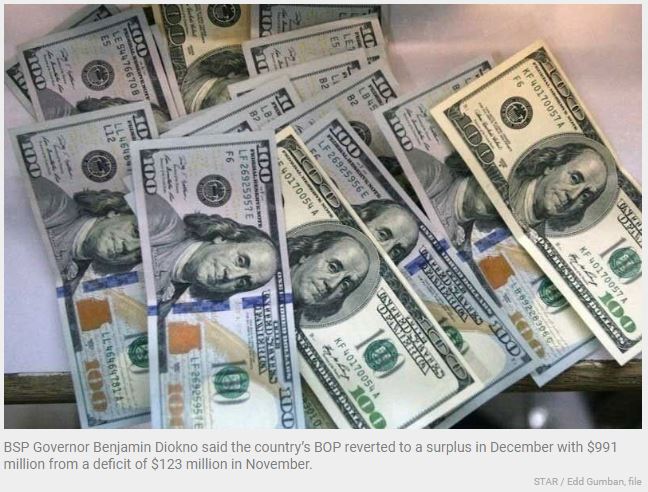Philippines: BOP surplus hits $1.3 billion, falls short of 2021 target
MANILA, Philippines — The Philippines recorded a narrower $1.34 billion balance of payments (BOP) surplus in 2021, falling short of the $1.6 billion target for the period, the Bangko Sentral ng Pilipinas (BSP) said.
BSP Governor Benjamin Diokno said the country’s BOP reverted to a surplus in December with $991 million from a deficit of $123 million in November.
Last month’s BOP surplus was 76.6 percent lower than the $4.24 billion booked in December 2020. This was also the highest in two months or since the $1.14 billion recorded in October last year.
“In December 2021, the BOP surplus reflected the structural inflows for the year, such as the BSP’s income from its investments abroad, personal remittances, trade in services, foreign direct investments and net foreign borrowings by the national government,” Diokno said.
However, Diokno explained that the wider trade in goods deficit moderated the inflows last month.
For 2021, the country’s BOP surplus plunged by 91.6 percent to $1.34 billion from an all-time high of $16.02 billion in 2020.
“The full-year surplus was lower than the $16.02 billion surplus recorded in 2020 and short of the projected surplus of $1.61 billion for the year,” the BSP chief said.
The BOP is the difference in total values between payments into and out of the country over a period.
A surplus means more US dollars flowed into the country’s exports, remittances from overseas Filipino workers (OFWs), business process outsourcing (BPO) earnings and tourism receipts than what flowed out to pay for the importation of more goods, services and capital.
Latest data from the central bank showed personal remittances climbed by 5.3 percent to $31.58 billion in end-November last year from $29.97 billion in end-November 2020.
Likewise, the net inflow of foreign direct investments (FDIs) jumped by 48 percent to $8.14 billion in end-October last year and exceeded the full-year 2021 target of $8 billion.
Meanwhile, latest data from the Philippine Statistics Authority (PSA) showed the country’s trade deficit swelled by 68.4 percent to $37.92 billion from January to November last year versus the $22.15 billion recorded in the same period in 2020.
This developed after imports jumped by 30.4 percent to $106.29 billion during the 11-month period from $81.51 billion, while exports increased by 15.2 percent to $68.37 billion from $59.36 billion.
The BSP earlier lowered its BOP surplus target to $1.6 billion instead of $4.1 billion for 2021 and $700 million instead of $1.7 billion for 2022 as the growth prospects of some advanced economies were significantly downgraded amid the spikes in COVID-19 cases due to the more contagious Omicron variant.
According to the central bank, the country’s BOP position reflects the increase in the gross international reserves (GIR) to $108.79 billion in end-2021, equivalent to 10.3 months of imports of goods and payments of services and primary income.
Michael Ricafort, chief economist at Rizal Commercial Banking Corp., said that any improvement in the BOP and the GIR in the coming months could help provide greater cushion and support for the peso exchange rate versus the US dollar amid speculative attacks.
“Still near record high GIR may also further strengthen the country’s external position, which in turn, fundamentally supports the country’s relatively favorable credit ratings as seen recently,” he said.
Despite the sea of downgrades globally, debt watchers S&P Global Ratings, Moody’s Investors Service and Fitch Ratings affirmed the investment grade rating of the Philippines.
Source: https://www.philstar.com/business/2022/01/27/2156556/bop-surplus-hits-13-billion-falls-short-2021-target


 English
English




